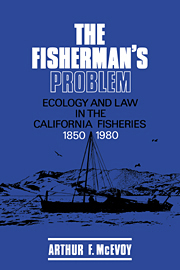Book contents
- Frontmatter
- Contents
- List of figures
- List of tables
- Preface
- Acknowledgments
- List of abbreviations
- Introduction
- 1 The problem of environment
- I The miner's canary
- II Sun, wind, and sail, 1850–1910
- III The industrial frontier, 1910–1950
- IV Enclosure of the ocean, 1950–1980
- Conclusion
- Appendixes
- Notes
- Selected bibliography
- Index
1 - The problem of environment
Published online by Cambridge University Press: 06 January 2010
- Frontmatter
- Contents
- List of figures
- List of tables
- Preface
- Acknowledgments
- List of abbreviations
- Introduction
- 1 The problem of environment
- I The miner's canary
- II Sun, wind, and sail, 1850–1910
- III The industrial frontier, 1910–1950
- IV Enclosure of the ocean, 1950–1980
- Conclusion
- Appendixes
- Notes
- Selected bibliography
- Index
Summary
With every day that passes we are acquiring a better understanding of these laws and getting to perceive both the more immediate and the more remote consequences of our interference with the traditional course of nature … the more this progresses the more will men not only feel but also know their oneness with nature, and the more impossible will become the senseless and unnatural idea of a contrast between mind and matter, man and nature, soul and body. …
– Frederick Engels (1876)The pelagic, or open-sea, fisheries of California owe their productivity to the California Current, a stream of water roughly 350 miles wide that flows slowly along the coast from north to south. Off the central California coast and in the Southern California Bight, winds and currents interact seasonally to generate upwellings of deep, cold, nutrient-rich water to the lighted surface of the ocean. Blooms of plankton fertilized by this upwelled water feed the coastal pelagic schooling fishes – sardine, anchovy, and the like – which in turn provide fodder for still other fish and mammals higher on the food chain. What portion of this great, complex aggregation of living matter, or biomass, that does not leave the system in the bellies of migratory animals or fishing boats dies and drifts slowly to the ocean floor, only to be upwelled later to enter the cycle again.
- Type
- Chapter
- Information
- The Fisherman's ProblemEcology and Law in the California Fisheries, 1850–1980, pp. 3 - 16Publisher: Cambridge University PressPrint publication year: 1986

